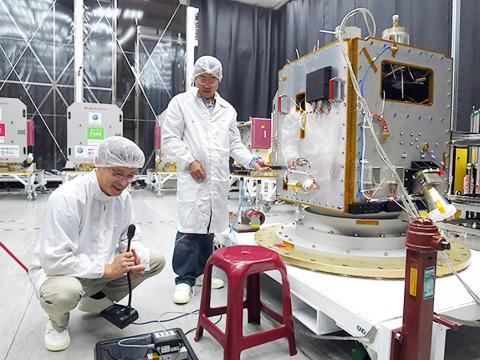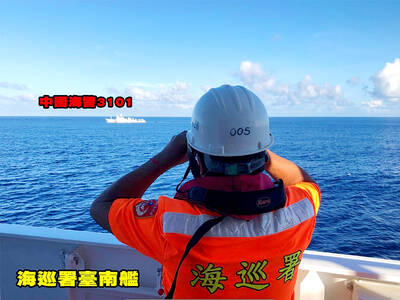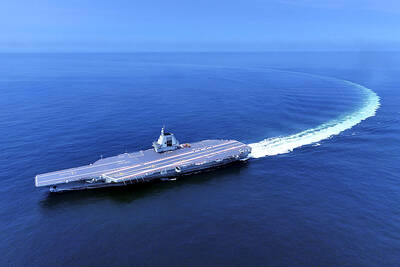The nation’s second domestically developed satellite, Triton (獵風者), is slated to be launched in the second half of 2021 by French firm Arianespace at a base in French Guiana, the National Space Organization (NSPO) said on Friday.
Dubbed the “Wind Hunter,” the satellite will be tasked with gathering data about sea wind and working with the Formosat-7 constellation to advance the nation’s weather forecasting capacity, NSPO Deputy Director-General Yu Shiann-jen (余憲政) said.
The six-satellite Formosat-7 constellation — a Taiwan-US collaborative program — was launched by the US company SpaceX with other foreign satellites from the Kennedy Space Center in Florida on June 25.

Photo provided by the National Space Organization
The nation’s first domestically developed satellite Formosat-5, a remote-sensing satellite, was also launched by SpaceX on Aug. 25, 2017 from the Vandenberg Air Space in California.
For the Triton launch, two companies — Arianespace and another foreign firm — competed for the bid, Yu said.
Most of Triton’s critical components and payload instruments were developed by Taiwanese personnel, with its ratio of indigenous development reaching 87 percent, 9 points higher than for Formosat-5, he said.
Its payload instrument — the Global Navigation Satellite System Reflectometry (GNSS-R) — as well as other critical components, such as the onboard computer, the power control unit, the GPS receiver and a fiber-optic gyro, were developed by NSPO personnel, Yu said.
The cubic satellite, measuring about 280kg, is equipped with a deployable solar panel on one side, according to Triton’s project description on the NSPO’s Web site.
It will be launched with other satellites from an orbit of 500km to 600km from the ground, with an inclination angle of no smaller than 24°, while the actual parameters should be confirmed along with other satellites, the NSPO said.
Some of the techniques used in developing Triton were an improvement on those used in Formosat-5, and they would be further advanced when developing the nation’s next satellite program, Formosat-8, a remote-sensing satellite, Yu said.
Additional reporting by CNA

The first two F-16V Bock 70 jets purchased from the US are expected to arrive in Taiwan around Double Ten National Day, which is on Oct. 10, a military source said yesterday. Of the 66 F-16V Block 70 jets purchased from the US, the first completed production in March, the source said, adding that since then three jets have been produced per month. Although there were reports of engine defects, the issue has been resolved, they said. After the jets arrive in Taiwan, they must first pass testing by the air force before they would officially become Taiwan’s property, they said. The air force

The Coast Guard Administration (CGA) yesterday said it had deployed patrol vessels to expel a China Coast Guard ship and a Chinese fishing boat near Pratas Island (Dongsha Island, 東沙群島) in the South China Sea. The China Coast Guard vessel was 28 nautical miles (52km) northeast of Pratas at 6:15am on Thursday, approaching the island’s restricted waters, which extend 24 nautical miles from its shoreline, the CGA’s Dongsha-Nansha Branch said in a statement. The Tainan, a 2,000-tonne cutter, was deployed by the CGA to shadow the Chinese ship, which left the area at 2:39pm on Friday, the statement said. At 6:31pm on Friday,

The Chinese People’s Liberation Army Navy’s (PLAN) third aircraft carrier, the Fujian, would pose a steep challenge to Taiwan’s ability to defend itself against a full-scale invasion, a defense expert said yesterday. Institute of National Defense and Security Research analyst Chieh Chung (揭仲) made the comment hours after the PLAN confirmed the carrier recently passed through the Taiwan Strait to conduct “scientific research tests and training missions” in the South China Sea. China has two carriers in operation — the Liaoning and the Shandong — with the Fujian undergoing sea trials. Although the PLAN needs time to train the Fujian’s air wing and

STRIKE: Some travel agencies in Taiwan said that they were aware of the situation in South Korea, and that group tours to the country were proceeding as planned A planned strike by airport personnel in South Korea has not affected group tours to the country from Taiwan, travel agencies said yesterday. They added that they were closely monitoring the situation. Personnel at 15 airports, including Seoul’s Incheon and Gimpo airports, are to go on strike. They announced at a news conference on Tuesday that the strike would begin on Friday next week and continue until the Mid-Autumn Festival next month. Some travel agencies in Taiwan, including Cola Tour, Lion Travel, SET Tour and ezTravel, said that they were aware of the situation in South Korea, and that group